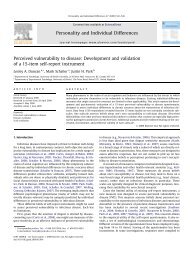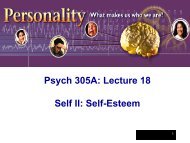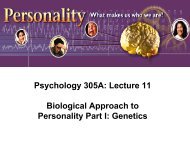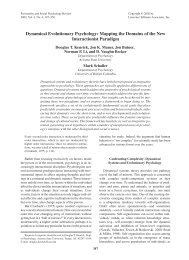Culture and the Self: Implications for Cognition, Emotion, and ... - iacmr
Culture and the Self: Implications for Cognition, Emotion, and ... - iacmr
Culture and the Self: Implications for Cognition, Emotion, and ... - iacmr
Create successful ePaper yourself
Turn your PDF publications into a flip-book with our unique Google optimized e-Paper software.
CULTURE AND THE SELF 249<br />
Cousins, S. (1989). <strong>Culture</strong> <strong>and</strong> selfhood in Japan <strong>and</strong> <strong>the</strong> U.S. Journal<br />
of Personality <strong>and</strong> Social Psychology, 56,124-131.<br />
Dalai, A. K.., Sharma, R., & Bisht, S. (1983). Causal attributions of<br />
ex-criminal tribal <strong>and</strong> urban children in India. Journal of Social<br />
Psychology, 119,163-171.<br />
DAndrade, R. (1981). The cultural part of cognition. Cognitive Science,<br />
5,179-185.<br />
Darwin, C. R. (1896). The expression of emotions in man <strong>and</strong> animals.<br />
New York: Philosophical Library.<br />
Davis, M. H., & Stephan, W G. (1980). Attributions <strong>for</strong> exam per<strong>for</strong>mance.<br />
Journal of Applied Social Psychology, 10, 235-248.<br />
De Riviera, J. (1984). The structure of emotional relationships. In P.<br />
Shaver (Ed.), Review of personality <strong>and</strong> social psychology: <strong>Emotion</strong>s,<br />
relationships, <strong>and</strong> health (pp. 116-145). Beverly Hills, CA: Sage.<br />
De Vos, G. A. (1973). Socialization <strong>for</strong> achievement: Essays on <strong>the</strong> cultural<br />
psychology of <strong>the</strong> Japanese. Berkeley: University of Cali<strong>for</strong>nia<br />
Press.<br />
De Vos, G. (1985). Dimensions of <strong>the</strong> self in Japanese culture. In A.<br />
Marsella, G. De Vos, & F. L. K. Hsu (Eds.), <strong>Culture</strong> <strong>and</strong> self (pp.<br />
149-184). London: Tavistock.<br />
Doi, L. T. (1973). The anatomy of dependence. Tokyo: Kodansha.<br />
Doi, T. (1986). The anatomy of self: The individual versus society. Tokyo:<br />
Kodansha.<br />
Dumont, L. (1970). Homo hierarchicus. Chicago: University of Chicago<br />
Press.<br />
Durkheim, E. (1968). Les <strong>for</strong>mes elementaires de la vie religieuse [Basic<br />
<strong>for</strong>ms of religious belief] (6th ed.). Paris: Presses Universitarires de<br />
France. (Original work published 1912)<br />
Ekman, P. (1972). Universals <strong>and</strong> cultural differences in facial expression<br />
of emotion. In J. K. Cole (Ed.), Nebraska symposium on motivation<br />
(pp. 207-283). Lincoln: University of Nebraska Press.<br />
Elvin, M. (1985). Between <strong>the</strong> earth <strong>and</strong> heaven: Conceptions of <strong>the</strong><br />
self in China. In M. Carri<strong>the</strong>rs, S. Collins, & S. Lukes (Eds.), The<br />
category of <strong>the</strong> person: Anthropology, philosophy, history (pp. 156-<br />
189). New York: Cambridge University Press.<br />
Erikson, E. (1950). Identification as <strong>the</strong> basis <strong>for</strong> a <strong>the</strong>ory of motivation.<br />
American Psychological Review, 26,14-21.<br />
Fenigstein, A. (1984). <strong>Self</strong>-consciousness <strong>and</strong> <strong>the</strong> overperception of self<br />
as a target. Journal of Personality <strong>and</strong> Social Psychology, 47, 860-<br />
870.<br />
Fenigstein, A., Scheier, M. E, & Buss, A. H. (1975). Public <strong>and</strong> private<br />
self-consciousness: Assessment <strong>and</strong> <strong>the</strong>ory. Journal of Consulting<br />
<strong>and</strong> Clinical Psychology, 43, 522-527.<br />
Festinger, L., & Carlsmith, J. M. (1959). Cognitive consequences of<br />
<strong>for</strong>ced compliance. Journal of Abnormal <strong>and</strong> Social Psychology, 58,<br />
203-210.<br />
Fiedler, F. E. (1978). Recent development in research on <strong>the</strong> contingency<br />
model. In L. Berkowitz (Ed.), Group processes (pp. 209-225).<br />
New York: Academic Press.<br />
Fiske, A. P. (in press). Making up society: The four elementary relational<br />
structures. New \brk: Free Press.<br />
Fiske, S. T, & Taylor, S. E. (1984). Social cognition. Reading, MA: Addison-Wesley.<br />
Frijda, N. H., Kuipers, P., & ter Schure, E. (1989). Relations among<br />
emotion appraisal <strong>and</strong> emotional action readiness. Journal of Personality<br />
<strong>and</strong> Social Psychology, 57,212-228.<br />
Galtung, J. (1981). Structure, culture, <strong>and</strong> intellectual style: An essay<br />
comparing Saxonic, Teutonic, Gallic <strong>and</strong> Nipponic approaches. Social<br />
Science In<strong>for</strong>mation, 20, 817-856.<br />
Geertz, C. (1974). From <strong>the</strong> native's point of view: On <strong>the</strong> nature of<br />
anthropological underst<strong>and</strong>ing. In K. Basso & H. Selby (Eds.),<br />
Meaning in anthropology (pp. 221 -237). Albuquerque: University of<br />
New Mexico Press.<br />
Geertz, C. (1975). On <strong>the</strong> nature of anthropological underst<strong>and</strong>ing.<br />
American Scientist, 63, 47-53.<br />
Gergen, K. J. (1968). Personal consistency <strong>and</strong> <strong>the</strong> presentation of self.<br />
In C. Gordon & K. J. Gergen (Eds.), The self in social interaction:<br />
Classic <strong>and</strong> contemporary perspectives (Vol. 1, pp. 299-308). New<br />
York: Wiley.<br />
Gergen, K. J., & Gergen, M. M. (1988). Narrative <strong>and</strong> <strong>the</strong> self as relationship.<br />
In L. Berkowitz (Ed.), Advances in experimental social psychology<br />
(Vol. 21, pp. 17-56). New York: Academic Press.<br />
Gilligan, C. (1982). In a different voice: Psychological <strong>the</strong>ory <strong>and</strong><br />
women's development. Cambridge, MA: Harvard University Press.<br />
Gilligan, C. (1986). Remapping <strong>the</strong> moral domain: New images of <strong>the</strong><br />
self in relationship. In T. C. Heller, M. Sosna, & D. E. Wellbery (Eds.),<br />
Reconstructing individualism: Autonomy, individuality, <strong>and</strong> <strong>the</strong> self in<br />
Western thought (pp. 237-252). Stan<strong>for</strong>d, CA: Stan<strong>for</strong>d University<br />
Press.<br />
Gilmor, T. M., & Reid, D. W (1979). Locus of control <strong>and</strong> causal attribution<br />
<strong>for</strong> positive <strong>and</strong> negative outcomes on university examinations.<br />
Journal of Research in Personality, 13,154-160.<br />
Gilovich, T. (1983). Biased evaluation <strong>and</strong> persistence in gambling.<br />
Journal of Personality <strong>and</strong> Social Psychology, 40, 797-808.<br />
Goethals, A. (1989, April). Studies of false uniqueness. Paper presented<br />
at <strong>the</strong> Research Center <strong>for</strong> Group Dynamics Seminar, Institute <strong>for</strong><br />
Social Research, University of Michigan, Ann Arbor, MI.<br />
Greenberg, J., Pyszczynski, T., & Solomon, S. (1982). The self-serving<br />
attributional bias: Beyond self-presentation. Journal of Experimental<br />
Social Psychology, 18, 56-67.<br />
Greenwald, A. G. (1980). The totalitarian ego: Fabrication <strong>and</strong> revision<br />
of personal history American Psychologist, 35, 603-618.<br />
Greenwald, A. G, & Pratkanis, A. R. (1984). The self. In R. S. Wyer & T.<br />
K. Srull (Eds.), H<strong>and</strong>book of social cognition (Vol. 3, pp. 129-178).<br />
Hillsdale, NJ: Erlbaum.<br />
Hall, C. S., & Lindzey, G. (1957). Theories of personality. New York:<br />
Wiley.<br />
Hallowell, A. I. (1955). <strong>Culture</strong> <strong>and</strong> experience. Philadelphia: University<br />
of Pennsylvania Press.<br />
Hamaguchi, E. (1985). A contextual model of <strong>the</strong> Japanese: Toward a<br />
methodological innovation in Japan studies. Journal of Japanese<br />
Studies, 77,289-321.<br />
Harkins, S. G., Latane, B., & Williams, K. (1980). Social loafing: Allocating<br />
ef<strong>for</strong>t or taking it easy? Journal of Experimental Social Psychology,<br />
16, 457-465.<br />
Barter, S. (1983). The development of <strong>the</strong> self-system. In E. M. He<strong>the</strong>rington(Ed.),<br />
H<strong>and</strong>book of child psychology: ti)l. 4. Socialization, personality,<br />
<strong>and</strong> social development (4th ed.). New York: Wiley.<br />
Harter, S. (1990). Causes, correlates <strong>and</strong> <strong>the</strong> functional role of global<br />
self-worth: A life span perspective. In R. J. Sternberg & J. Kolligian,<br />
Jr. (Eds.), Competence considered (pp. 67-97). New Haven, CT: Yale<br />
University Press.<br />
Hayashi, C. (1988). National character of <strong>the</strong> Japanese. Tokyo: Statistical<br />
Bureau, Japan.<br />
Head, H. (1920). Studies in neurology. London: Ox<strong>for</strong>d University<br />
Press.<br />
Heelas, P. L. F, & Lock, A. J. (Eds.). (1981). Indigenous psychologies:<br />
The anthropology of <strong>the</strong> self London: Academic Press.<br />
Hess, R., Azuma, H., Kashiwagi, K., Dickson, W P., Nagano, S., Holloway,<br />
S., Miyake, K., Price, G., Hatano, G., & McDevitt, T. (1986).<br />
Family influences on school readiness <strong>and</strong> achievement in Japan<br />
<strong>and</strong> <strong>the</strong> United States: An overview of a longitudinal study. In H.<br />
Stevenson, H. Azuma, & K. Hakuta (Eds.), Child development <strong>and</strong><br />
education in Japan (pp. 147-166). New York: Freeman.<br />
Hilgard, E. R. (1953). Introduction to psychology. New York: Harcourt,<br />
Brace.







